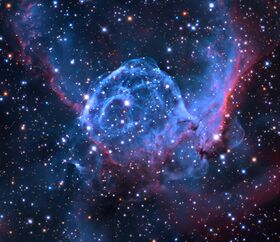Astronomy:WR 7
| Observation data Equinox J2000.0]] (ICRS) | |
|---|---|
| Constellation | Canis Major |
| Right ascension | 07h 18m 29.1311s[1] |
| Declination | −13° 13′ 01.514″[1] |
| Characteristics | |
| Spectral type | WN4-s[2] |
| U−B color index | −0.47[3] |
| B−V color index | +0.28[3] |
| Astrometry | |
| Proper motion (μ) | RA: −3.601[1] mas/yr Dec.: −2.998[1] mas/yr |
| Parallax (π) | 0.2096 ± 0.0268[1] mas |
| Distance | approx. 16,000 ly (approx. 4,800 pc) |
| Absolute magnitude (MV) | −3.8[4] |
| Details | |
| Mass | 13[2] M☉ |
| Radius | 1.26[2] R☉ |
| Luminosity | 229,000[2] L☉ |
| Other designations | |
| Database references | |
| SIMBAD | data |
WR 7 (HD 56925) is a Wolf–Rayet star in the constellation of Canis Major. It lies at the centre of a complex bubble of gas which is shocked and partially ionised by the star's radiation and winds.
The distance is uncertain, with estimates between 3.5 kiloparsecs (11,410 light-years) and 6.9 kiloparsecs (22,500 light-years). Assuming a distance of 4.8 kiloparsecs (15,600 light-years), this star is calculated to be 229,000 times brighter than the Sun, 13 times more massive, and 1.26 times larger with a surface temperature of 112,200 K. This makes it currently the second smallest known WN star in the galaxy, after WR 2.
Stars of its kind are characterised by a rapid loss of stellar mass, driven by chemically enriched high-speed stellar winds. It is estimated that it loses mass at the rate of 7x10−5 solar masses each year through winds of 1,545 km/s.[5]
The ring nebula NGC 2359 is excited by the ionising radiation of WR7. It is also known as Thor's Helmet or the Duck Nebula. The ring is approximately 4pc across and prominent at wavelengths from radio to X-ray.[5][6]
References
- ↑ 1.0 1.1 1.2 1.3 1.4 Vallenari, A. et al. (2022). "Gaia Data Release 3. Summary of the content and survey properties". Astronomy & Astrophysics. doi:10.1051/0004-6361/202243940 Gaia DR3 record for this source at VizieR.
- ↑ 2.0 2.1 2.2 2.3 Cite error: Invalid
<ref>tag; no text was provided for refs namedhamann - ↑ 3.0 3.1 Reed, B. Cameron (1998). "UBVβ Database for Case-Hamburg Northern and Southern Luminous Stars". The Astrophysical Journal Supplement Series 115 (2): 271–275. doi:10.1086/313088. Bibcode: 1998ApJS..115..271R.
- ↑ Crowther, Paul A.; Rate, Gemma (2020). "Unlocking Galactic Wolf–Rayet stars with Gaia DR2 – I. Distances and absolute magnitudes". Monthly Notices of the Royal Astronomical Society 493 (1): 1512–1529. doi:10.1093/mnras/stz3614. Bibcode: 2020MNRAS.493.1512R.
- ↑ 5.0 5.1 Cappa, C. E.; Goss, W. M.; Niemela, V. S.; Ostrov, P. G. (1999). "A Study of Neutral and Ionized Gas of the Wolf-Rayet Ring Nebula NGC 2359". The Astronomical Journal 118 (2): 948. doi:10.1086/300995. Bibcode: 1999AJ....118..948C.
- ↑ Zhekov, S. A. (2014). "X-rays from wind-blown bubbles: An XMM-Newton detection of NGC 2359". Monthly Notices of the Royal Astronomical Society 443 (1): 12–18. doi:10.1093/mnras/stu1138. Bibcode: 2014MNRAS.443...12Z.
External links
- NASA Astronomy Picture of the Day: NGC 2359: Thor's Helmet (15 February 2014)
- NASA Astronomy Picture of the Day: Thor's Helmet (5 June 2010)
- NASA Astronomy Picture of the Day: The Seagull and the Duck (19 March 2010)
- NGC 2359 Thor's Helmet Images of the Universe
- Galactic Wolf–Rayet Catalogue
- NGC 2359 Thor's Helmet - Duck Nebula (HaR)GB Astrobin
 |


